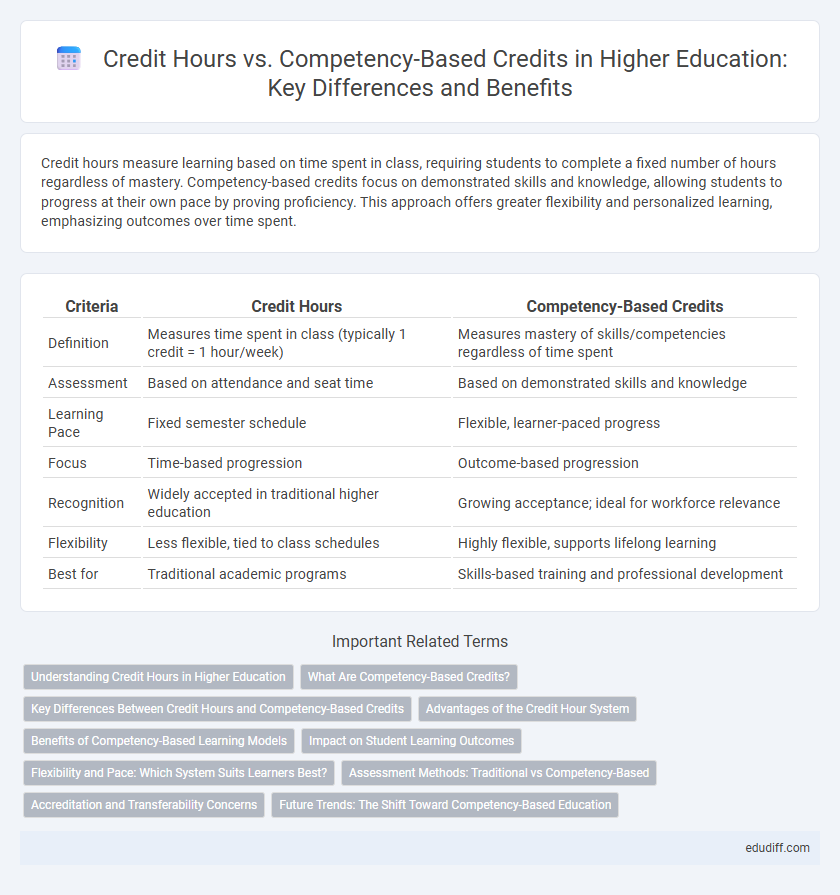Credit hours measure learning based on time spent in class, requiring students to complete a fixed number of hours regardless of mastery. Competency-based credits focus on demonstrated skills and knowledge, allowing students to progress at their own pace by proving proficiency. This approach offers greater flexibility and personalized learning, emphasizing outcomes over time spent.
Table of Comparison
| Criteria | Credit Hours | Competency-Based Credits |
|---|---|---|
| Definition | Measures time spent in class (typically 1 credit = 1 hour/week) | Measures mastery of skills/competencies regardless of time spent |
| Assessment | Based on attendance and seat time | Based on demonstrated skills and knowledge |
| Learning Pace | Fixed semester schedule | Flexible, learner-paced progress |
| Focus | Time-based progression | Outcome-based progression |
| Recognition | Widely accepted in traditional higher education | Growing acceptance; ideal for workforce relevance |
| Flexibility | Less flexible, tied to class schedules | Highly flexible, supports lifelong learning |
| Best for | Traditional academic programs | Skills-based training and professional development |
Understanding Credit Hours in Higher Education
Credit hours in higher education quantify the amount of time a student spends in class, typically based on weekly hours per semester, serving as a standardized measure for course completion. Each credit hour usually corresponds to one hour of classroom instruction and two hours of outside study per week over a 15-week semester, totaling around 45 contact hours. Understanding credit hours is crucial for academic planning, transcript evaluation, and meeting degree requirements within traditional semester systems.
What Are Competency-Based Credits?
Competency-based credits measure student learning by demonstrating mastery of specific skills or knowledge rather than time spent in class, aligning assessments with real-world outcomes. Unlike traditional credit hours that quantify educational progress through seat time, competency-based credits prioritize practical abilities and results, enabling personalized learning paces. This approach supports flexible degree completion paths, benefiting adult learners and professionals seeking skills validation without fixed classroom schedules.
Key Differences Between Credit Hours and Competency-Based Credits
Credit hours measure academic progress based on time spent in class, typically quantifying coursework by the number of instructional hours per week over a semester. Competency-based credits evaluate a student's mastery of specific skills or knowledge, allowing for flexible pacing and recognition of prior learning. The primary distinction is that credit hours link education to seat time, while competency-based credits focus on demonstrated proficiency regardless of time spent.
Advantages of the Credit Hour System
The credit hour system provides a standardized metric for measuring educational progress, making it easier for institutions to evaluate and transfer credits across programs and universities. It offers a structured timeline that supports consistent pacing for both students and instructors, fostering a predictable learning environment. The widespread acceptance and regulatory recognition of credit hours facilitate eligibility for financial aid and accreditation, ensuring broader educational and career opportunities.
Benefits of Competency-Based Learning Models
Competency-based learning models offer flexible pacing and personalized pathways, allowing students to progress upon mastery rather than time spent in class. This approach enhances skill acquisition and real-world application, aligning education with workforce demands more effectively than traditional credit hour systems. Employers benefit from graduates whose competencies are clearly demonstrated, bridging the gap between academic achievement and professional readiness.
Impact on Student Learning Outcomes
Credit hours measure time spent in class, often limiting personalized learning, while competency-based credits assess mastery of specific skills, promoting deeper understanding and practical application. Students advancing through competency-based systems demonstrate improved retention and real-world problem-solving abilities by progressing only after proving proficiency. This approach aligns learning outcomes with individual strengths, enhancing motivation and ensuring that academic achievements reflect actual competencies.
Flexibility and Pace: Which System Suits Learners Best?
Competency-based credits offer greater flexibility and self-paced learning, allowing students to progress upon mastery rather than time spent in class, which benefits learners with varying schedules or learning speeds. Traditional credit hours follow a fixed timeline based on seat time, providing structure that some students may need to stay motivated and on track. Understanding learner preferences and life circumstances helps determine whether the adaptable, mastery-focused competency model or the time-regulated credit hour system aligns best with individual educational goals.
Assessment Methods: Traditional vs Competency-Based
Traditional credit hours rely on time-based assessments such as exams, essays, and timed assignments to evaluate student performance, emphasizing seat time and standardized grading. Competency-based credits use performance-based assessments including projects, portfolios, and real-world tasks to measure mastery of skills and knowledge regardless of time spent. This method aligns assessment outcomes with specific competencies, allowing personalized pacing and practical demonstration of learning.
Accreditation and Transferability Concerns
Accreditation standards often favor credit hours for their standardized measurement of instructional time, posing challenges for competency-based credits that assess mastery instead of seat time. Transferability concerns arise as many institutions and accrediting bodies hesitate to recognize competency-based credits due to inconsistent evaluation frameworks and lack of uniform credit equivalency. Ensuring alignment with established accreditation criteria and developing clear credit conversion guidelines are critical for broader acceptance and transferability of competency-based learning achievements.
Future Trends: The Shift Toward Competency-Based Education
Higher education is increasingly shifting toward competency-based education (CBE), emphasizing mastery of specific skills over traditional credit hours. This trend is driven by growing demand for personalized learning, workforce alignment, and flexible pathways that recognize real-world competencies. Institutions adopting CBE models report improved student engagement and outcomes, signaling a transformative future for credit recognition in academia.
Credit Hours vs Competency-Based Credits Infographic

 edudiff.com
edudiff.com